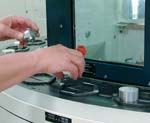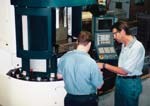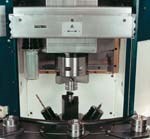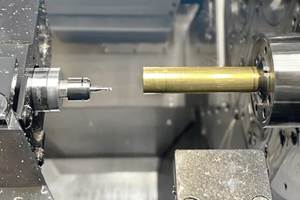Machine Shop Hikes Productivity By 'Turning Lathe On End'
Midwest Screw Products is a contract manufacturing operation for the aerospace, computer, medical, electronics, energy, telecommunications and fluid process industries.
Share





Midwest Screw Products (Eastlake, Ohio) is a contract manufacturing operation for the aerospace, computer, medical, electronics, energy, telecommunications and fluid process industries. The company has a mix of multi-spindle chuckers and bar machines but found its capacity stretched by new orders. Production of one precision compression fitting posed a special challenge for Midwest's horizontal two-axis CNC lathes. The hex-shaped stainless steel part required eight distinct secondary turning and milling operations. Notoriously stringy stainless steel chips and the expected high production volumes promised to make the job even more of a bottleneck.
"We figured we'd lose lots of time mainly during the loading cycle, cleaning the chuck, clearing chips and loading the next part," recalls plant manager and programmer Steve Zuzek. "We knew we wanted automatic loading and unloading but thought we'd just have to live with the chip-jamming problems."
A search for an automated solution soon centered on the EMAG VL3 inverted vertical spindle lathe from Hardinge (Elmira, New York). This machining concept suspends the headstock from an overhead carriage on linear roller guides above a 12-station turret carrying driven and static tools. The 21-hp overhead spindle of the VL3 turns at up to 7,500 rpm, 3 1/2 times faster than the spindles on horizontal bar machines. A 16-hp turret spindle enables live tooling under the workpiece to mill and drill stationary parts once they are turned.
The inverted spindle and coolant jets in the enclosed machining cube facilitate chip evacuation, hands-off, and prevent tools from re-cutting chips. A universal conveyor surrounding the work area accommodates parts of any shape up to 8.6 inches in diameter. With its glass scales, chip conveyor and mist collector, the integrated system costs 40 percent less than a horizontal lathe with separate bar feeder and chip conveyor, and it requires about half the shopfloor space.
Midwest Screw Products chose the EMAG VL3 because the machine provided flexibility to feed, turn and mill parts at higher production rates than other CNC machines, with minimal operator attention. "The big thing is you are no longer limited by the availability of an operator for either part handling or chip disposal," explains Mr. Zuzek. "With the VL3, as long as you have parts on the conveyor, it's going to load itself. And with the vertical configuration. . .chips simply fall out of the way."
Midwest Screw Products typically assigns each operator one or two machines. The unattended operation of the new vertical lathe enabled an existing worker to serve a third machine.
In operation, compression-fitting blanks approximately 11/2-inch long by 9/16-inch diameter come to the vertical lathe from other multi-spindle machines. An operator loads 14 pieces at a time onto the built-in part feed conveyor. Workholding prisms that adjust to the programmed workpiece diameter grip the blanks, and the conveyor advances pieces to the overhead chuck. The machine faces, turns, drills, finish turns and finish bores, then roll cuts threads and roll-stamps each part.
Total cycle time per part is about 75 seconds. "Actual cutting time is about the same as for a conventional horizontal CNC lathe," says Mr. Zuzek, "but utilization, and therefore throughput, is up. We gain throughput because an operator doesn't have to open the door, open the chuck, remove the part, clear chips, load the chuck, close the chuck, close the machine door and push a button." Time to load 14 parts on the conveyor is 42 seconds, versus approximately 5 minutes to feed the same number of parts manually. Chipmaking time from one part to the next is about 20 percent less than the same job done on a horizontal lathe. "We reclaimed 12 minutes of machining time per hour through higher utilization," says Mr. Zuzek.
The vertical lathe with its wraparound spindle maintains dimensional tolerances on the compression fitting within 0.0015 inch. The rigid machine with its stable base also provides a surprise benefit. "It's still tough to estimate, but our tool life might be as much as 30 percent better," says Mr. Zuzek.
The cumulative effect of faster loading, faster part changes and less downtime for tool changes is more parts per day. Midwest Screw Products turns out 300 compression fittings per day on the vertical lathe versus about 230 per day on a conventional lathe.
Quick, easy setup is important for Midwest Screw Products to change from one job to another. "For an automated machine, it's very user-friendly during setup," says Mr. Zuzek. "When you're programming it, there's not a lot of homework to do as far as the fixtures go. The machine handles a number of shapes very easily." The auto-loading system of the vertical lathe also has a cardanic sensing plate at the part pick-up station to ensure workpieces are properly seated in the chuck.
"The Hardinge-EMAG VL3 is probably the best designed and best built machine in our shop," says company president Rick Creveling. "Maintenance is easy due to the accessibility of hydraulic, electrical and mechanical components. Overall, this machine has improved our productivity and profitability."
Related Content
Top Shops: Designing a Shop to Meet Customer Needs
Working closely with customers and making careful investments has enabled this Wisconsin machine shop to tackle difficult jobs with tight deadlines as a core part of its business.
Read MoreInside the Premium Machine Shop Making Fasteners
AMPG can’t help but take risks — its management doesn’t know how to run machines. But these risks have enabled it to become a runaway success in its market.
Read MoreInverting Turning and Five-Axis Milling at Famar
Automation is only the tip of the iceberg for Famar, which also provides multitasking options for its vertical lathes and horizontal five-axis machine tools.
Read More3 Tips to Accelerate Production on Swiss Lathes with Micro Tools
Low RPM lathes can cause tool breakage and prevent you from achieving proper SFM, but live tooling can provide an economical solution for these problems that can accelerate production.
Read MoreRead Next
Registration Now Open for the Precision Machining Technology Show (PMTS) 2025
The precision machining industry’s premier event returns to Cleveland, OH, April 1-3.
Read More5 Rules of Thumb for Buying CNC Machine Tools
Use these tips to carefully plan your machine tool purchases and to avoid regretting your decision later.
Read MoreSetting Up the Building Blocks for a Digital Factory
Woodward Inc. spent over a year developing an API to connect machines to its digital factory. Caron Engineering’s MiConnect has cut most of this process while also granting the shop greater access to machine information.
Read More


















.jpg;maxWidth=300;quality=90)







.jpg;maxWidth=300;quality=90)









